TUESDAY
OCTOBER 16 - 2012
NORE
BARN
09:15 - 10:30 - Tide
rising to high water at 12:25. Sunny but with a strong
SW wind.
Nore
Barn stream
I watched the stream
filling up with the tide for a little over an hour.
The Greenshank was the first on the scene, as usual,
followed by the Little Egret. But there was still no
sign of the Spotted Redshank which has now been
missing for 5 days following the two early sightings
last week on Oct 9 and 10.
First
Brent Geese
Two Brent Geese were
swimming into the stream this morning along with the
11 Wigeon I saw yesterday. These were the first Brents
I have seen in Emsworth Harbour this autumn.
OTHER
NEWS
Short-eared
Owls
While I was at Nore
Barn, I spoke to a man walking his dog who asked me if
I knew about the five Short-eared Owls on Fowley
island. A friend of his who has fishing nets there
told him about them. Interestingly, Barry Collins
reported his first Short-eared Owl of the autumn on
Thorney Island on Oct 14.
Black-necked
Grebe
A lady birdwatcher I
met at Nore Barn told me she had recently seen a
Black-necked Grebe in the Nore Barn Creek. I have no
further information about this, but as far as I am
aware there have been no local sightings. Ralph
Hollins reports recent sightings of one in Poole
Harbour on Oct 10 followed by another at the Dungeness
RSPB site.
Garden squirrel
A Grey Squirrel spent
a long time this afternoon collecting peanuts, which I
had only recently put on the feeding station and bird
table. It was not eating them, but burying them around
the garden. This is the first time I have witnessed
this common behaviour in my garden.
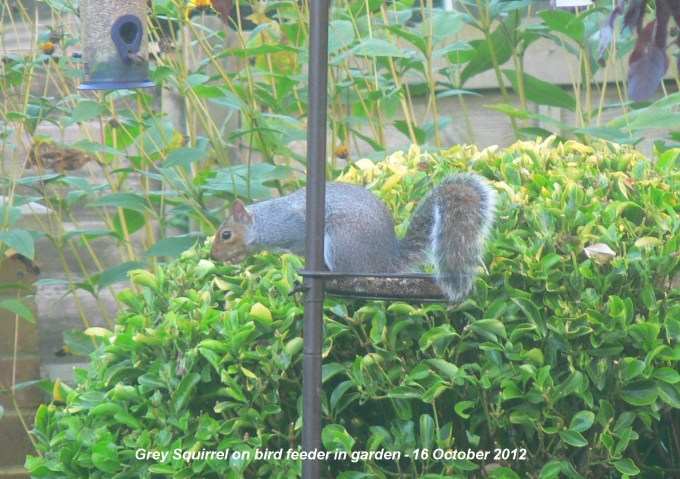
Small
Coppers
I saw two Small Copper
butterflies on this afternoon's walk, one on the new
Emsworth Railway Station wayside and the other on
Brook Meadow. Barry Collins tells me he had 11 Small
Coppers (3rd brood) on Thorney Island on Sunday. These
today were probably also the 3rd brood.
Here
is a Small Copper feeding on Common Fleabane on the
Emsworth Railway Station wayside
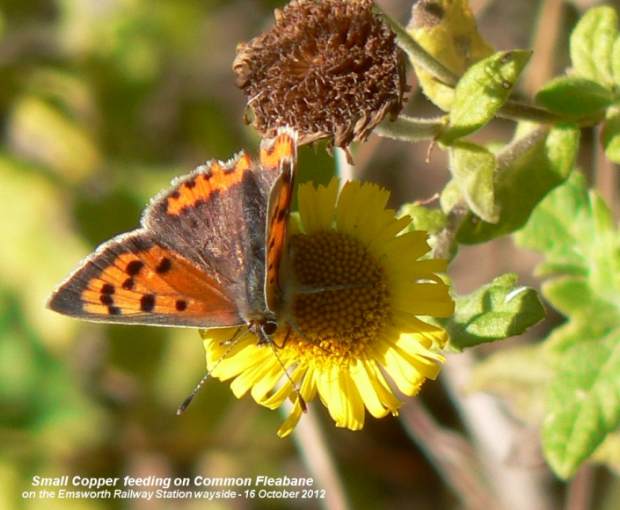
Other
insects
Also, on Brook Meadow
I saw a rather tatty looking Red Admiral and male
Common Darter
Mystery
Bumblebee - Bombus pascuorum
Bryan Pinchen
confirmed my hunch that the Bumblebee with a black and
grey striped abdomen that I photographed feeding on
the Michaelmas Daisies on Brook Meadow on Oct 14 was
in fact another Bombus pascuorum. Bryan
says the banded appearance of the abdomen is a result
of the abdomen being slightly stretched by the feeding
position so it shows the hair bands on each of the
abdominal segments, an easy problem to encounter. When
the abdomen is less stretched they have the usual
completely hairy appearance of a bumblebee.
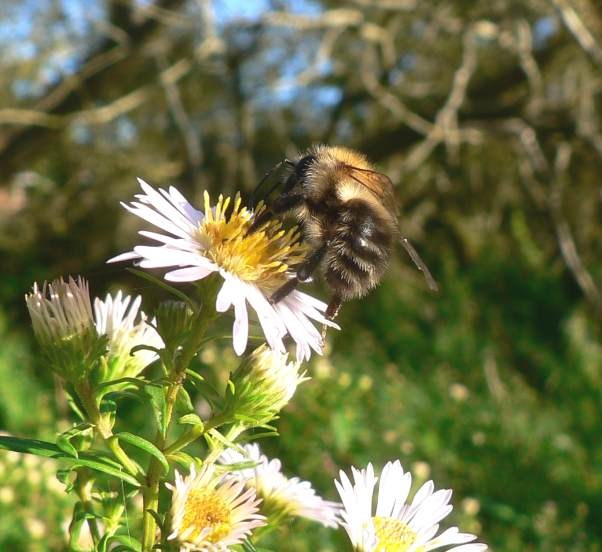
MONDAY
OCTOBER 15 - 2012
NORE
BARN
08:30 - 09:45 - High
water at 11:42. I decided to get down to Nore Barn on
the rising tide today. I stayed until the stream was
fairly full.
Still
no Spotted Redshank
The Greenshank flew
onto the stream to be followed by the Little Egret and
a single Black-tailed Godwit. But the Spotted Redshank
did not show up for the 4th day running. I was
interested to see how relaxed the Greenshank was in
response a dog that raced into the stream; it simply
moved onto the bank and waited for the dog to go. I
also had a Cormorant swimming in the rapidly filling
stream and two Teal.
Here
are the Greenshank and the Little Egret feeding
together in the Nore Barn stream
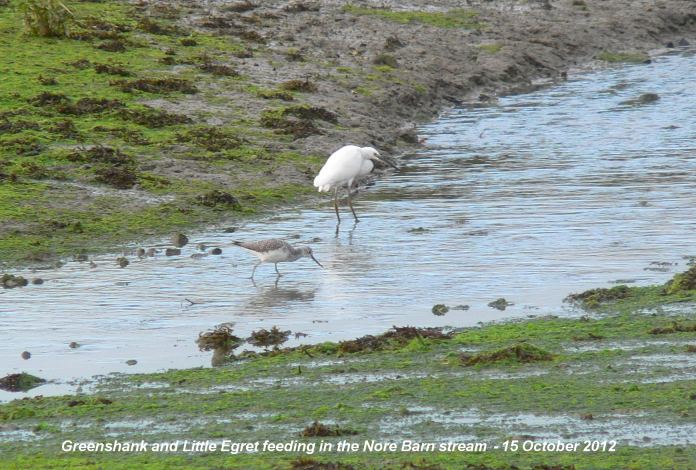
Black-tailed
Godwits
A flock of 34
Black-tailed Godwits arrived on the mudflats off Nore
Barn to be followed by more as the tide rose. I
counted a maximum of 82 feeding mostly on the edge of
the saltmarshes. I found two colour-ringed birds among
them:
O+WL - My 3rd
sighting here this autumn.
ROL+RLR - This
is a Kent-ringed Godwit (27-Oct-08) with three rings
on each leg. My 1st sighting here this autumn. It has
been regular in Emsworth Harbour over the past three
winters. The first sightings are usually in
mid-October and the last ones in Jan-Feb. Last winter
we had a total of 43 sightings of ROL+RLR from
08-Oct-11 to 11-Feb-12.

First
Wigeon
A flotilla of 11
Wigeon were in the channel - the first of the
year in Emsworth. Further out were a large flock of
Shelduck - approximately 40. A Grey Wagtail was
flitting around on the shingle beach. This was my
second sighting of it this autumn.
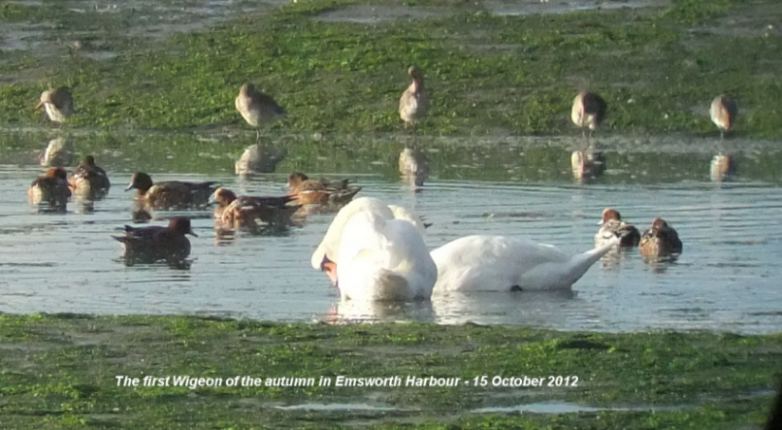
BROOK
MEADOW
I heard a Great Tit
singing on Brook Meadow this afternoon. First this
autumn.
Albino
Common Comfrey?
Regarding the white
flowered Common Comfrey (see Oct 12 entry) Ralph
Hollins notes that Stace's Flora says .. "The flowers
are often wrongly described as white but except for
very rare albinos they are pale creamy yellow or
purplish" Ralph suggests that the Brook Meadow plant
qualifies as a 'very rare albino'. If you want to see
it the plant is on the river bank south of the S-bend
and before the sluice gate.
Here
is my photo of the white flowering Common Comfrey
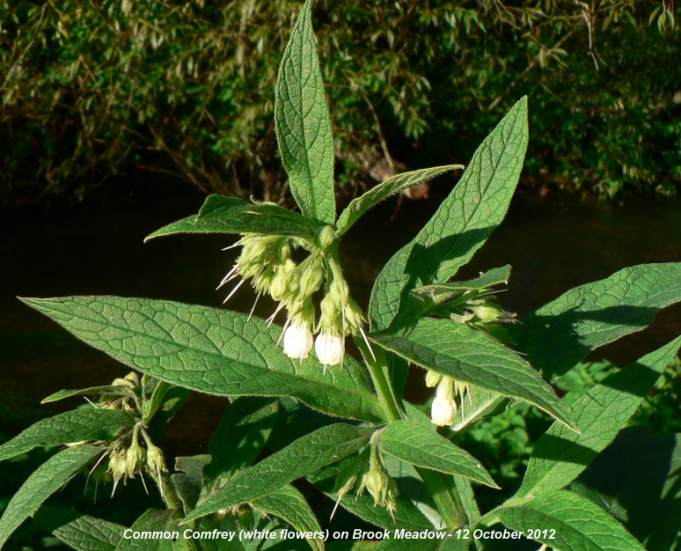
SUNDAY
OCTOBER 14 - 2012
NORE
BARN
14:00 - 14:30 - A fine
afternoon with a chilly northerly wind. Sea fairly
calm. Tide falling from high water at 11:00. I did my
now regular check of the Nore Barn stream. Greenshank
and Little Egret arrived at about 14:15, but again
there was no sign of the Spotted Redshank for the 3rd
day running. I wonder where it has got to? Thorney
Island is my best guess.
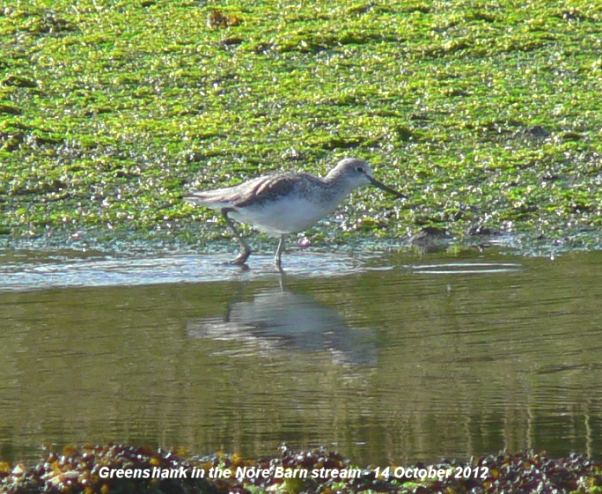
There were no
Black-tailed Godwits at all on the western mudflats,
though I did see about 30 feeding on the emerging
mudflats to the east of the Emsworth Sailing Club
building. There were plenty of Shelduck further out on
the mudflats, but no Brent Geese.
Other
observations
A deep blue male
Migrant Hawker was flying around the bushes at
the end of the gardens. It did not rest long enough
for a photo, but I am fairly sure of the
identification.
What was probably the
same Red Admiral that I have seen for the past
3 days was also flying near the woods.
The Chicken of the
Woods fungus is still looking quite fresh on the
tree stump on the grass verge on the east side of
Beacon Square. I first saw it here on Oct 3rd.
BROOK
MEADOW
I enjoyed a late
afternoon walk through Brook Meadow - the 'golden
hour', so I am told, for photographers. So I took a
few photos, not that I would describe myself in any
way as a photographer.
The flowers on the
bank of Michaelmas Daisies are only just
starting to open. It is a pity these plants have a bad
reputation in conservation work, since they are a very
good late nectar source. There were several Bumblebees
feeding on them when I was there, including some
ginger ones with grey and black bands on the abdomen.
I suspect they are a form of Bombus pascuorum though
they could be another type of bee, not a Bumblebee,
called Anthophora plumipes (Chinery p. 48). I will ask
Bryan Pinchen for his verdict.
Bryan Pinchen
confirmed my hunch that the Bumblebee with a black and
grey stiped abdomen that I photographed feeding on the
Michaelmas Daisies on Brook Meadow on Oct 14 was in
fact another Bombus pascuorum. Bryan
says the banded appearance of the abdomen is a result
of the abdomen being slightly stretched by the feeding
position so it shows the hair bands on each of the
abdominal segments, an easy problem to encounter. When
the abdomen is less stretched they have the usual
completely hairy appearance of a bumblebee.

The Alder
Buckthorn bushes below the causeway have a very
good crop of black berries this year.
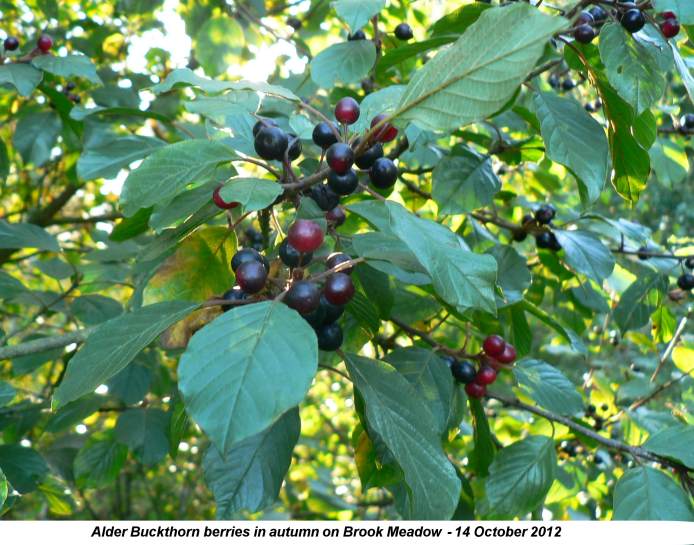
The taller of the
planted Black Poplar trees looks very fine from
the causeway.

Bristly
Ox-tongue was flowering well on the north meadow.
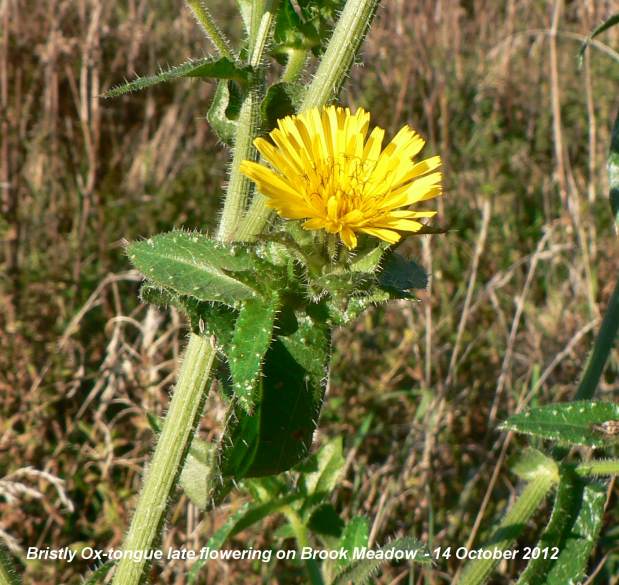
The seedheads of
Great Willowherb make a fine show.
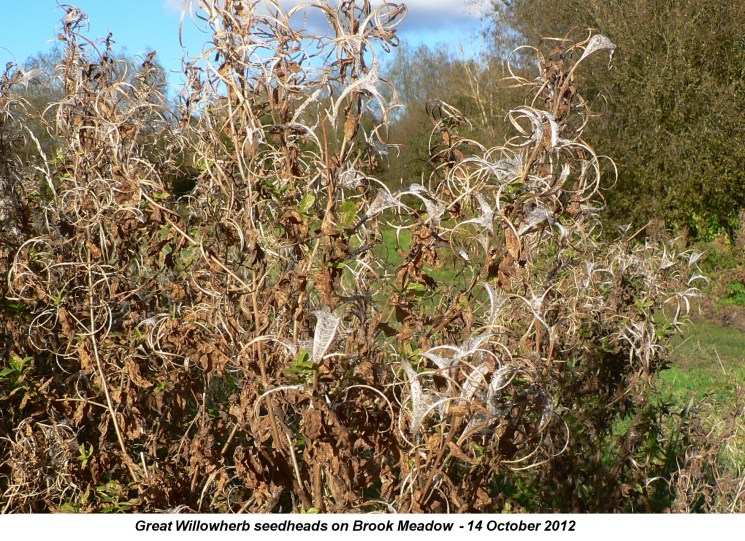
Finally, here are a
few Teasel seedheads.
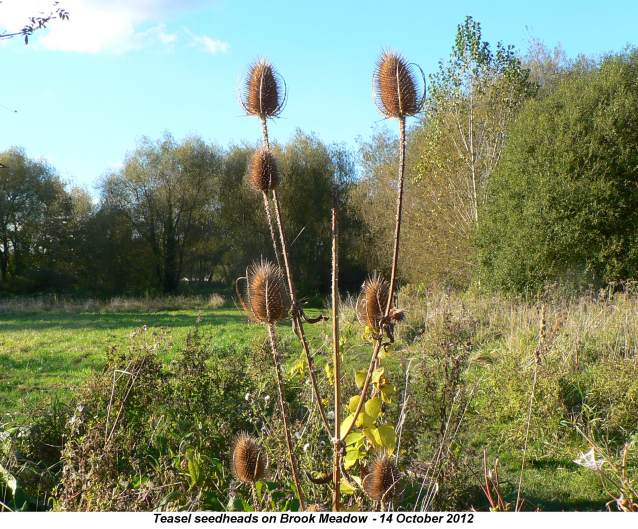
SATURDAY
OCTOBER 13 - 2012
NORE
BARN
13:30 - 14:00 - I
spent half an hour watching the birds in the vicinity
of the Nore Barn stream as the tide fell (3-4 hours
after high water). For the second day running the
Spotted Redshank did not appear, though the Greenshank
was present today along with the regular Little Egret.

It is too early to get
concerned as the bird probably has yet to get into a
proper feeding routine. I had a walk along the shore
to the top of Nore Barn Creek. Another Greenshank was
feeding on the far edge of the channel, but no sign of
the Spotshank.
It was good to see so
lots of Golden Samphire still in flower along the
seawall.
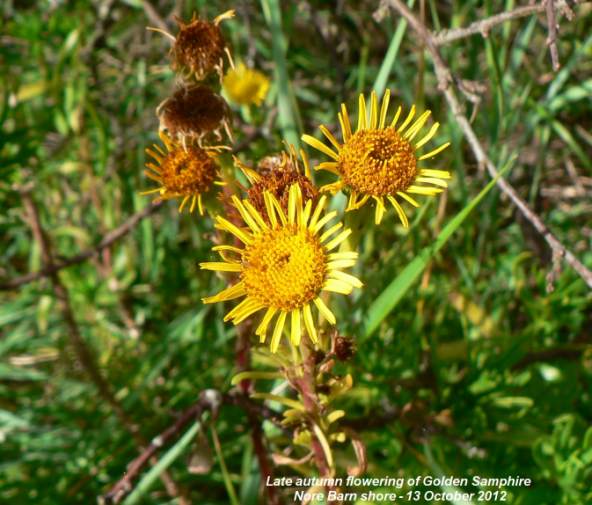
CUBA
And for something a
bit different . . . Malcolm Phillips is just back from
Cuba and sent me a couple of bird photos. Here is one
of a Stripe-headed Tanager - what a fine bird.
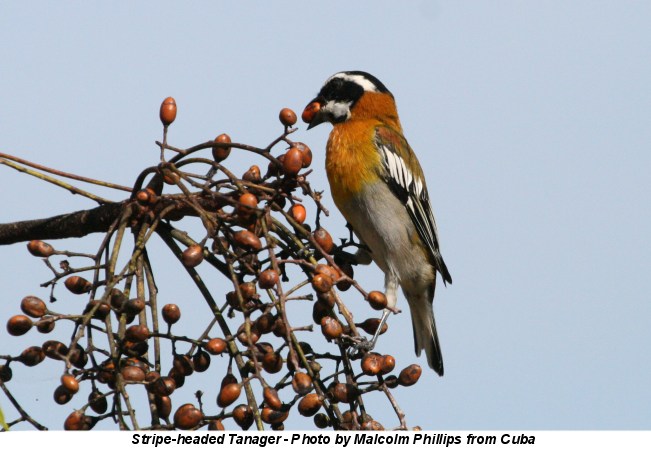
FRIDAY
OCTOBER 12 - 2012
BROOK
MEADOW
White
flowering comfrey
Ralph Hollins was on
Brook Meadow yesterday and noticed a white flowering
comfrey along the main river path which he thought
might be White Comfrey (Symphytum orientale), which
would be a new plant for the Brook Meadow list. I had
a look at it this morning, but I am fairly sure it is
a white flowered Common Comfrey.
As can be seen in the
following photo, the stems have the characteristic
'wings' of Common Comfrey (which White Comfrey does
not have) and the calyx teeth are fairly long and
sharp (they would be short and blunt in White
Comfrey). I checked the nearby purple flowering
comfrey which had the same characteristics.

Russian
Vine
Ralph also mentioned a
plant of Russian Vine what is now flowering in the
woodwork of the Seagull Lane entrance. This has been
there in previous years and clearly has strayed from
the large plant climbing over the bushes immediately
opposite the gate.
Bumblebees
- Bombus pascuorum
Two ginger Bumblebees
were feeding on the Common Comfrey with purple
flowers, one of which had a full pollen sack on its
leg. I thought they might be Bombus pascuorum
workers which Chinery says are the latest flying
Bumblebee. I sent this photo to Bryan Pinchen who
confirmed the identification.
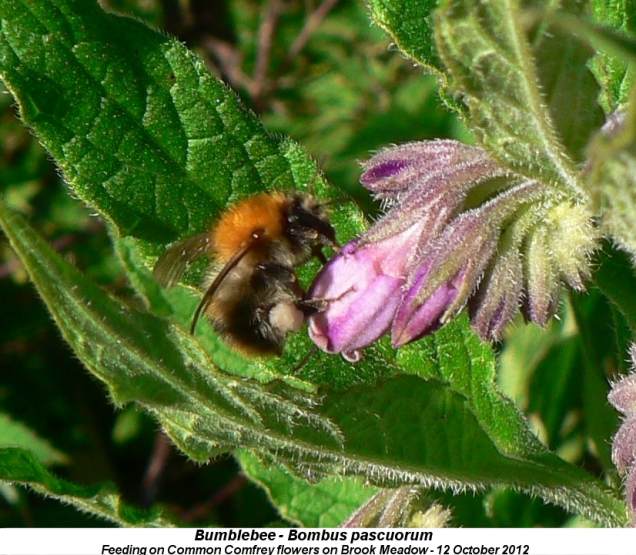
Bryan added "this
species does often continue until this late, this year
it's probably more down to the wet and cool weather
throughout the summer which would have made it hard to
fully provision the nest, hence workers still busy
this late. I've not seen any for a couple of weeks,
but there are still plenty of Red Admirals around on
the ivy". Bryan provides a link to his fascinating
commentary on the Dung beetle on his blog at . . .
http://shoutingatseahorses.wordpress.com/
A highly recommended blog for regular visits.
Common
Darter
A late male Common
Darter was basking in the warm sunshine.

Chiffchaff
A Chiffchaff was
active in the old Elder bush on the river bank just
north of the purple flowered Common Comfrey.
Chiffchaffs are regular summer visitors to Brook
Meadow and some usually stay into autumn when their
sweet whistles can be heard around the meadow. One or
two may even remain here through the winter.
NORE
BARN
12:00 - 13:00 - I
waited for an hour while the tide fell in the western
harbour, watching the small stream as it emptied. A
Little Egret was feeding in the stream for most of the
time along with an Oystercatcher and a Curlew, plus an
increasing number of Black-headed Gulls. However,
there was no sign of the Spotted Redshank or the
Greenshank. I also checked the shore in front of the
woods, but they were not there either. I hope this
does not mean a change in their feeding habits.
Shoreline
conservation project
Friends of Nore Barn
Woods report that HBC have made a good start on the
shoreline work. After one week good progress has been
made on protecting the most vulnerable section of the
shoreline. Full details are on the web site . . .
http://www.norebarnwoods.org.uk/Coastal%20Protection.htm
WEDNESDAY
OCTOBER 10 - 2012
EMSWORTH
HARBOUR
Nore
Barn stream
09:45 - About 2 1/2
hours after high water. Weather conditions were a big
improvement on yesterday with calm sea, light wind and
good visibility. A Grey Wagtail flew up from
the stream, heading for Maisemore Gardens - the first
one of the year.
Greenshank
was the only bird feeding in the stream when I
arrived

The
Spotted Redshank soon arrived with a typical 'chu-wit'
call
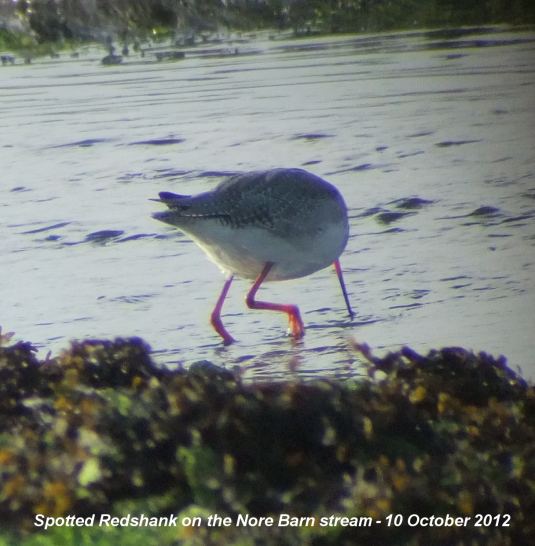
It was
followed by a Little Egret and a Common Redshank
For a while, all four were feeding in fairly close
proximity in the low water stream.
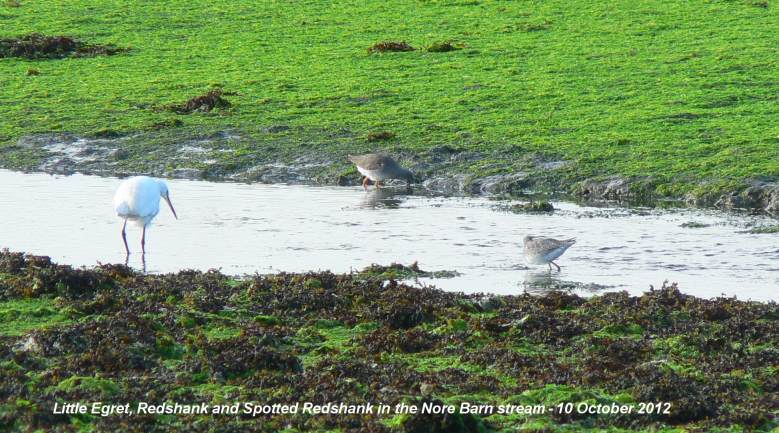
There was no sign of
the Spotshank chasing the Common Redshank as has
happened in previous years. However, the Spotshank was
itself chased out of the stream and into the harbour
by the Greenshank, something I had not witnessed
before. Maybe, they are all having to get used to each
other again.
Brian Lawrence arrived
to take some photos of the Spotted Redshank. The
Little Egret and the Common Redshank had by this time
flown, leaving the Spotshank and Greenshank feeding in
company with a couple of Black-headed Gulls.
Black-tailed
Godwits
10:30 - Meanwhile, the
Godwits were starting to collect in the Nore Barn
Woods channel and on the western mudflats as the tide
went out. The sun was troublesome trying to look for
colour-rings. I counted 90 godwits including one
colour-ringed bird: WO+LW flag which I also found here
on Oct 8.
11:30 - The tide
always falls much more slowly in the main channel to
the east of Emsworth. From the millpond seawall I
found 60 Black-tailed Godwits resting on the near side
of the channel and another 13 on the town shore,
making a total of 73. They included one colour-ringed
bird: G+WR - a regular here this season. What I am not
sure is whether these Godwits included some from the
western mudflats.
Other
observations
The first Grey
Plovers of the autumn in Emsworth were on the
western mudflats and on the main channel. A Red
Admiral was flying along the edge of Nore Barn Woods.
SKULLCAP
AT LUMLEY
I had a reply from
Martin Rand in response to the very poor Skullcap
specimen I sent him from the Lumley Stream. He thinks
it unlikely to be anything except Skullcap
(Scutellaria galericulata) in that habitat, and
nothing in the specimen indicated anything different.
However, if we can get some better material he should
be able to give a more definite answer. I shall try to
do that when Maurice Lillie (the chap who found it)
gets back from his holiday.
TUESDAY
OCTOBER 9 - 2012
EMSWORTH
HARBOUR
Spotted
Redshank is back
I have been checking
the Nore Barn stream regularly for the past week or
so, more in hope than expectation. I got there at
about 9.30 on a very murky morning with a light
drizzle in the air. The tide was falling - about 3 1/2
hours after high water. The mudflats were starting to
emerge and the stream was running well.
I was certainly not
expecting the Spotted Redshank to be back this early,
as my first sighting last year was on 21-Oct and my
earliest ever was 19-Oct the year before that. But
there it was, looking as sprightly as ever, feeding
actively in the stream along with its two 'friends'
the Little Egret and the Greenshank which have been
feeding there for the past couple of weeks. I have no
doubt that it is the same bird that has been coming
back to this area for the past nine winters.
From the BTO web site
the maximum recorded age for Spotted Redshank is 7
years 5 months 16 days (set in 1983). The present bird
clearly beats this record. However, I suspect the
British Trust for Ornithology record simply reflects
lack of data, as the the longevity record for the more
closely studied Greenshank is over 16 years and that
of Redshank over 20 years.
I took a number of
photos both digiscoped and normal though with the rain
falling steadily I needed to keep wiping the lenses.
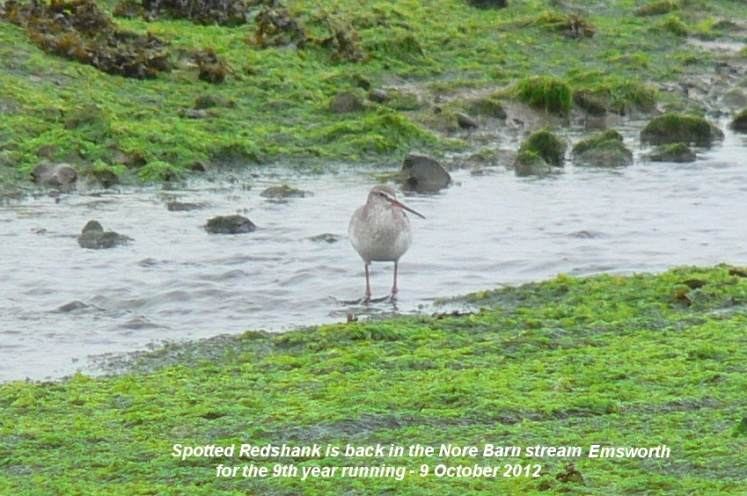
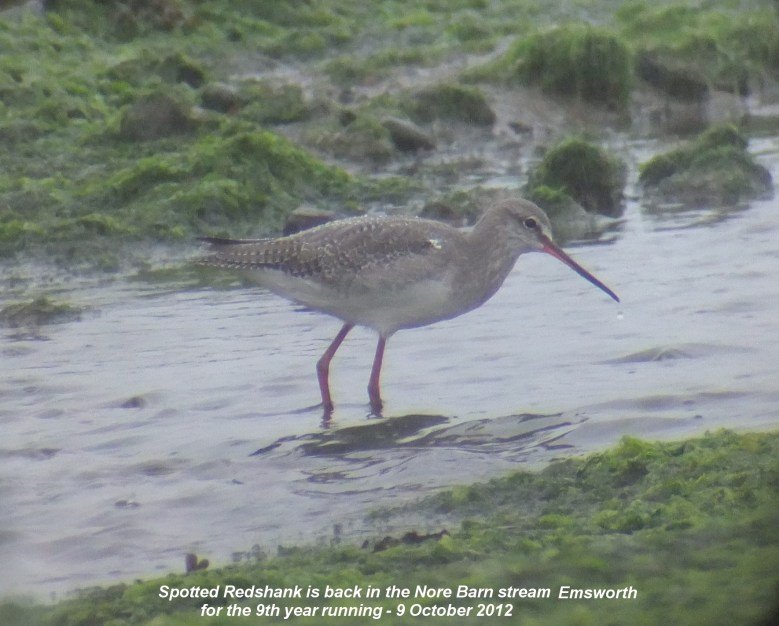
For
all the news about this bird and its history at
Emsworth go to . .
. Spotted
Redshank
A family of 5 swan
cygnets were also in the stream without their parents
and I wondered where they had come from. Langstone
Mill Pond maybe? Or Thorney Little Deeps?
About 20 Black-tailed
Godwits were feeding on the emerging mudflats, but the
conditions were too bad to look for colour-rings.
MONDAY
OCTOBER 8 - 2012
EMSWORTH
Black-tailed
Godwits
I checked the western
harbour at 12:00 with about 5 hours to high tide at
17:00. The conditions were poor, with a light drizzle
and rather misty. I counted 26 Black-tailed Godwits
feeding on the mudflats, including one colour-ringed
bird.
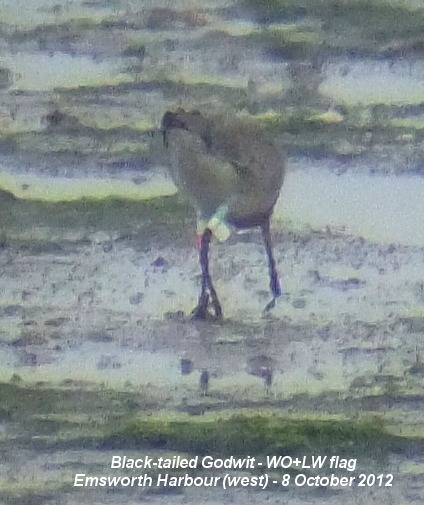
WO+LW flag -
This was ringed as a chick in Iceland by Ruth Croger
and Pete Potts on 13th July 2010. Fairly regular in
Emsworth over the past two winters: in 2010-11 from
16-Nov-10 to 26-Feb-11 and in 2011-12 from 03-Nov-11
to 07-Dec-11. This was our first sighting here this
season.
Patrick's
garden birds
Patrick Murphy sent me
a couple of photos of birds he had in his garden
today, both reasonably common in gardens at this time
of the year, though I wish I had them in mine!
The first is a male
Great Spotted Woodpecker with a red nape patch on the
head (the female lacks this red patch).
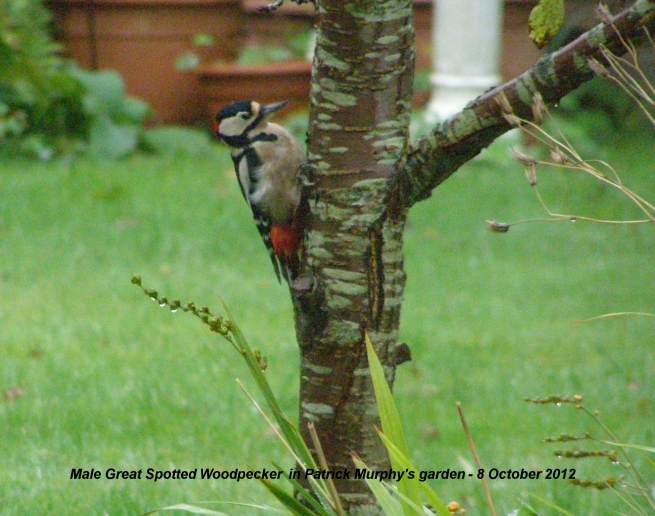
The second is a
Chiffchaff on the seed holder, distinguished by its
generally dull greenish plumage and pale supercilium.
I do not recall having seen a Chiffchaff on a seed
holder before. Insects must be getting short. It seems
to be saying to Patrick 'How about filling up this
feeder with some nice seeds?'

AUTUMN
JAYS
British Trust for
Ornithology reports the BirdTrack reporting rate for
Jay routinely climbs at this time of year, as birds
make regular foraging flights to collect and cache
food for the winter. However the rate for the first
week of October was the highest ever recorded in
BirdTrack, reaching 39 percent. Some of the Jays being
seen may be of continental origin, but there are also
native birds dispersing from breeding areas in search
of food as the acorn crop is very poor in some areas
this year. See . . . http://ctt-news.org/NXN-ZIXC-3GJW16-DW3JD-0/c.aspx
Here
is a Jay that was a surprise visitor to my garden in
May this year.
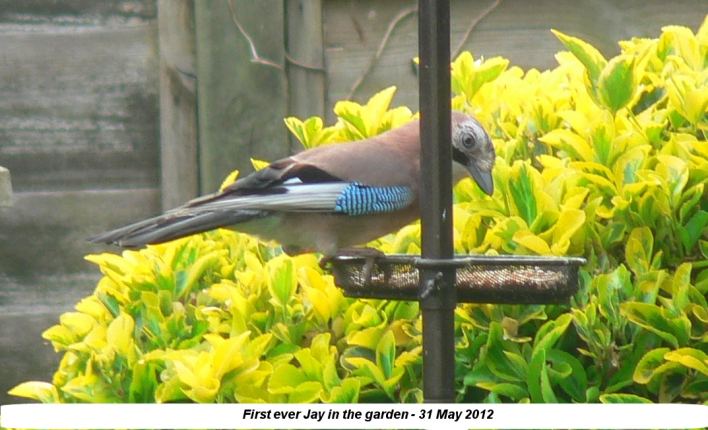
SUNDAY
OCTOBER 7 - 2012
Dead
Goldcrest
During the
conservation work session on Brook Meadow this
morning, Pam Phillips told me about a dead Goldcrest
in her garden, caught by a neighbour's cat. I went
over to get it and showed the beautiful creature to
all the volunteers. They were delighted to see it and
to feel such a small and delicate bird in the palm of
one's hand, as light as a feather and with a superb
gold crest with a touch of orange.

Young
Great Black-backed Gulls
The two juvenile Great
Black-backed Gulls from the Slipper Millpond nest are
still in the local area. Both were on the town
millpond this afternoon, feeding with the Black-headed
Gulls.
Skullcap
for Brook Meadow?
In a survey of the
Lumley Stream for the Brook Meadow Management Plan
Review, Maurice Lillie and Frances Jannaway discovered
a small plant growing on the east side bank. It looked
like a Skullcap (Scutellaria), which would be a new
plant for the Brook Meadow list. However, we were not
sure which one - the more common Skullcap (S.
galericulata) or Lesser Skullcap (S. minor).
Interestingly, the
common Skullcap has been present on the stream wall
outside the Lumley Road cottages for many years and it
would not be surprising if some of its seeds came down
stream to establish new plants on the Brook Meadow
site. However, the plant Maurice found in the stream
had characteristics suggesting Lesser Skullcap, which
would be more exciting.
I sent photos of the
plant to Ralph Hollins and to Martin Rand (the South
Hants Botanical Recorder) and to Ralph Hollins.
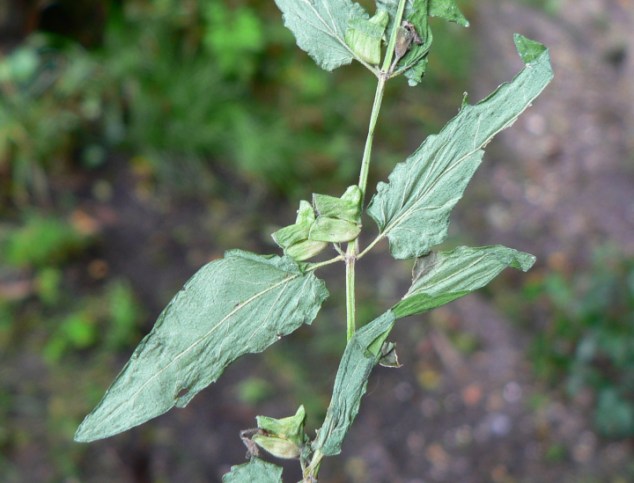
Ralph was strongly in
favour of Skullcap (S. galericulata) on the basis of
habitat, leaf shape and 'jizz', but thought Lesser
Skullcap could not be ruled out.
Martin also thought it
was most likely to be Skullcap (S. galericulata), but
said it looked a little odd with rather long petioles
and leaf teeth not much in evidence. He asked me to
send him a specimen. Unfortunately, Maurice who found
the original plant has gone away to Wales for 2 weeks
so is not here to show me exactly where he found it. I
have been in the stream on a couple occasions looking
for the plant without success. So, I had to send the
original rather dead specimen to Martin to see what he
makes of it.
FRIDAY
OCTOBER 5 - 2012
GARDEN
SPIDERS
Garden Spiders
(Araneus diadematus) are absolutely everywhere
at present. It is hard not to blunder into their webs
which are often stretched across paths and between
bushes. The spiders vary widely in colour from light
yellow to very dark grey, but all have mottled
markings across the back, with five or more large,
white dots forming a cross. My attention was caught by
this particularly colourful female spider on the new
Emsworth Railway Station wayside this
morning.
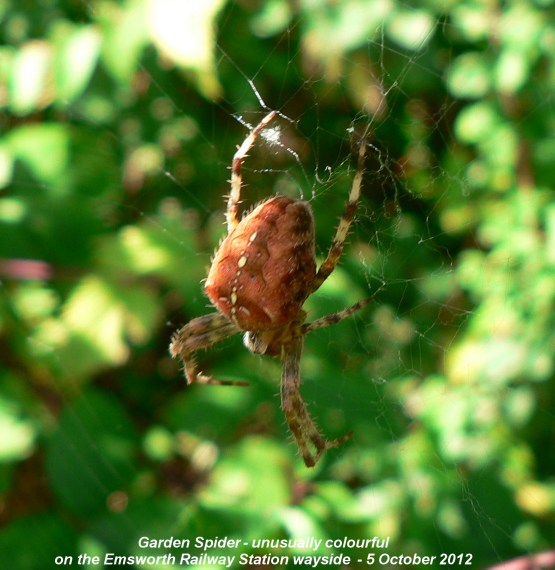
The large substantial
webs are always built by females. Males make webs,
although they tend to be not as big or substantial as
the webs of females. They need to make webs to capture
prey as they are not hunters. As adults the males
spend most of their time looking for females, and so
they don't tend to put much effort into
web-making.
In mating the much
smaller male approaches a female with caution in order
to avoid being eaten. During copulation, the male
embraces the female's abdomen; sperm is transferred by
the insertion of one of the male's palps.
Here is a link to an
astonishing 9 minute video on YouTube of a male
tentatively approaching a female for mating . . .
http://www.youtube.com/watch?v=3iqHcSkCFE8
The male departs after
mating, and the female spends a number of days inside
her retreat. She then begins to spin an egg sac or
'cocoon', which protects the eggs. She stays close to
the cocoon for a number of days before dying. The
young spiders emerge from the cocoon in spring; they
gather into dense groups until after their first
moult, after which they disperse by 'ballooning', a
form of dispersal in which the spiderlings are carried
on the wind by a thread of silk.
Spiderlings are black
and yellow and look almost identical to adults except
for the markings. Here is a photo of a nest of
spiderlings that I came across on Hayling Island in
June 2010.

WEDNESDAY
OCTOBER 3 - 2012
EMSWORTH
Eastern
harbour
11:00 - Tide rising to
high water at 13.54.
Black-tailed Godwits
were much as they were yesterday on the near and far
sides of the main channel. The godwits on the far side
progressively moved across as the water rose. I
counted 38 on the near shore and 76 on the far shore
making a grand total of 114, which is much the same as
yesterday. I checked about half of them for
colour-rings but found only one: G+BG - which is one
of the regulars this season.
Nore
Barn
Nothing of interest
here, but for the usual Greenshank in the stream. The
godwits clearly have not yet established the pattern
of assembling here, which they normally do later in
the season.
Chicken-of-the-Woods
fungus
I found a large
yellowish bracket-type fungus growing on a tree stump
on the roadside verge on the east side of Beacon
Square, generally pale with yellowish edges and
tiered. I broke off a bit and the flesh was bright
yellow. My tentative identification is Sulphur
Polypore or 'Chicken-of-the-Woods'. Apparently it is
good to eat, but with my poor record of choosing fungi
to eat, I did not attempt to taste it. Ralph Hollins
found some Chicken-of-the-Woods recently (Sep 24)
growing on an ornamental cherry or plum tree in a
Havant garden.

TUESDAY
OCTOBER 1 - 2012
EMSWORTH
HARBOUR
Eastern
harbour
10:00 - I got down to
the millpond seawall just over 3 hours to high water.
The tide was rising quickly as it always does in the
main Emsworth channel. High water was due at 13.24 ht
4.7. The conditions were not good for birdwatching
with a very strong SW wind blowing and occasional
showers. I sheltered on the shore behind the seawall.
The Black-tailed
Godwits were gathered on both sides of the channel
along with some Turnstone, Redshank and Black-headed
Gulls. Over the next hour I watched the godwits being
gradually squeezed onto the small island that remained
in the channel. Just before 11am some flew off towards
Thorney Island. A little later, the rest drifted off
in small groups, some moving onto the town shore.
I counted a maximum of
116, including at least 4 juvenile Godwits, with
variations in plumage. I managed to check about half
the godwits for colour-rings and found just
three:
G+BG - An
Emsworth regular. 4th sighting this season.
G+WR - An
Emsworth regular. 6th sighting this season.
O+WL - This is
a tricky one to identify with 100% certainty,
particularly the right leg rings. I am going for O+WL
though Y+WL or O+YL are possibilities. Two of these
colour-ringed combinations have been seen in Emsworth
this season: O+WL on Sept 25 at Nore Barn and O+YL in
Emsworth Harbour (east) on 17 July and also at
Fishbourne on Sept 7.
Nore
Barn
11:30 - The tide was
rising fast and the stream was filling up. The usual
Little Egret and unringed Greenshank were feeding
there with a single Black-tailed Godwit further out.
Three Teal were
in the Nore Barn creek with another 2 Black-tailed
Godwits on the edge of the saltmarshes.
For earlier observations go to . . . September
1-30